Abstract
In 1983, we reported results from the Oxford Family Planning Association contraceptive study regarding the association between oral contraceptives (OCs) and cervical neoplasia, after a 10 year follow-up of a cohort of 17,000 women. Further findings from this study are reported here after an additional 12 years of follow-up. A nested case--control design was used in which cases were all women diagnosed under 45 years of age with invasive carcinoma (n = 33), carcinoma in situ (n = 121) or dysplasia (n = 159). Controls were randomly selected from among cohort members and matched to cases on exact year of birth and clinic attended at recruitment to study. Conditional logistic regression analysis was used to determine odds ratios (ORs) and 95% confidence intervals (CIs) associated with various aspects of OC use relative to never users adjusted for social class, smoking, age at first birth and ever use of diaphragm or condom. Ever users of OCs had a slightly elevated OR for all types of cervical neoplasia combined (OR = 1.40, 95% CI 1.00-1.96). Odds ratios were highest for invasive carcinoma (OR = 4.44, 95% CI 1.04-31.6), intermediate for carcinoma in situ (OR = 1.73, 95% CI 1.00-3.00) and lowest for dysplasia (OR = 1.07, 95% CI 0.69-1.66). The elevated risk associated with OC use appeared to be largely confined to current or recent (last use in the past 2 years) long-term users of OCs. Among current or recent users, ORs for all types of cervical neoplasia combined were 3.34 (95% CI 1.96-5.67) for 49-72 months of use, 1.69 (95% CI 0.97-2.95) for 73-96 months and 2.04 (95% CI 1.34-3.11) for 97 or more months. These results suggest a possible effect of OC use on later stages of cervical carcinogenesis, although residual confounding due to sexual factors or human papillomavirus (HPV) infection cannot be ruled out.
Full text
PDF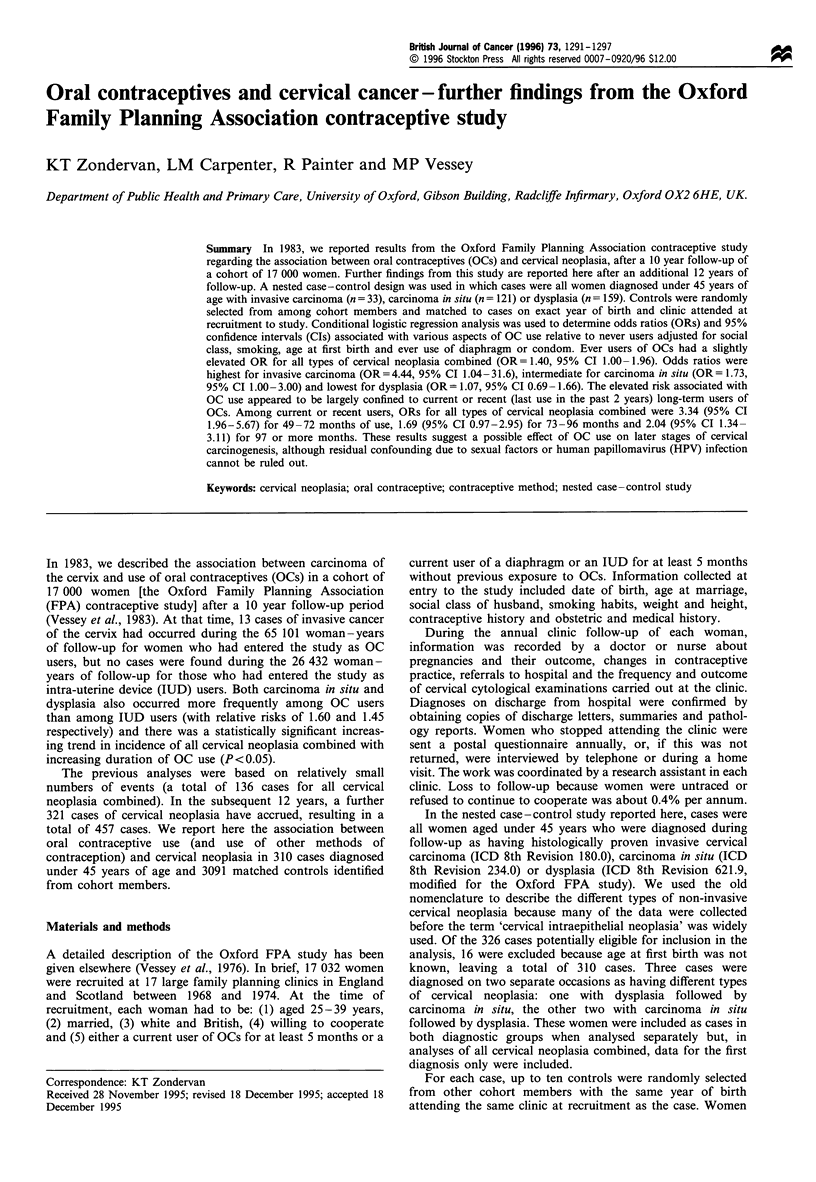
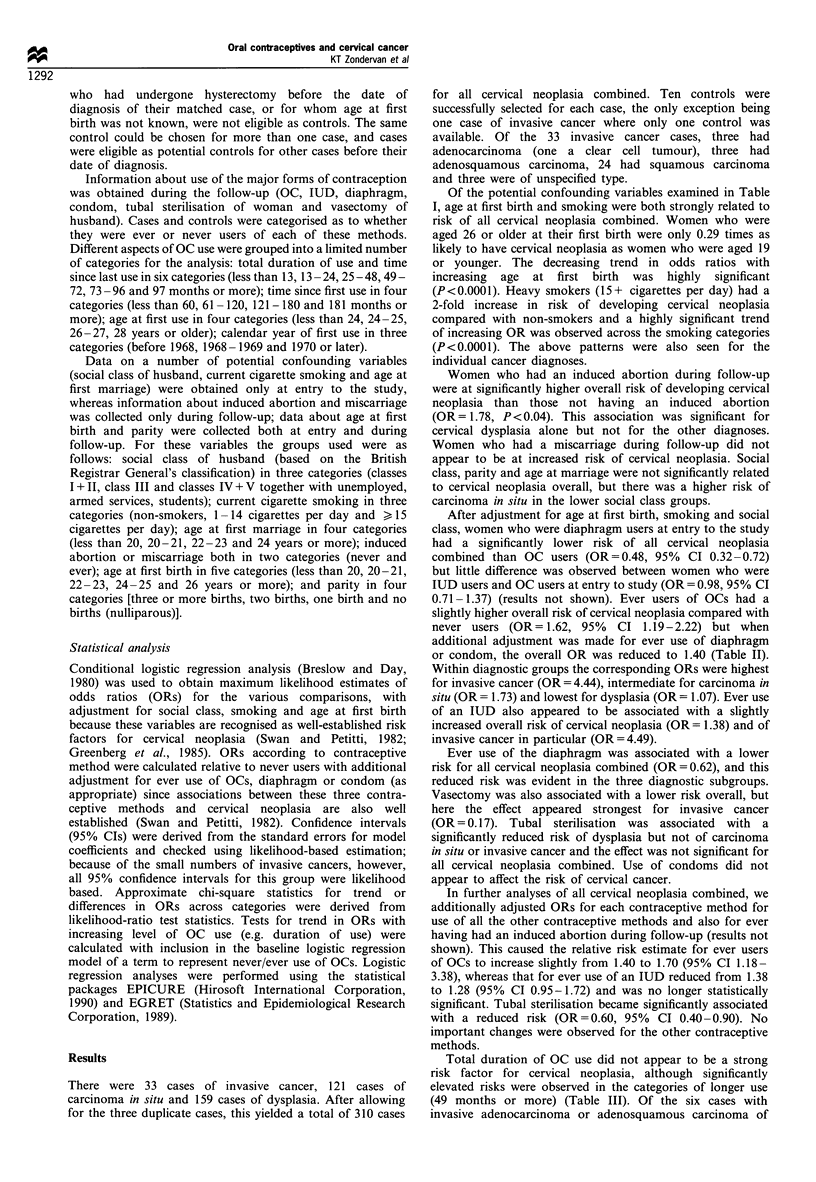
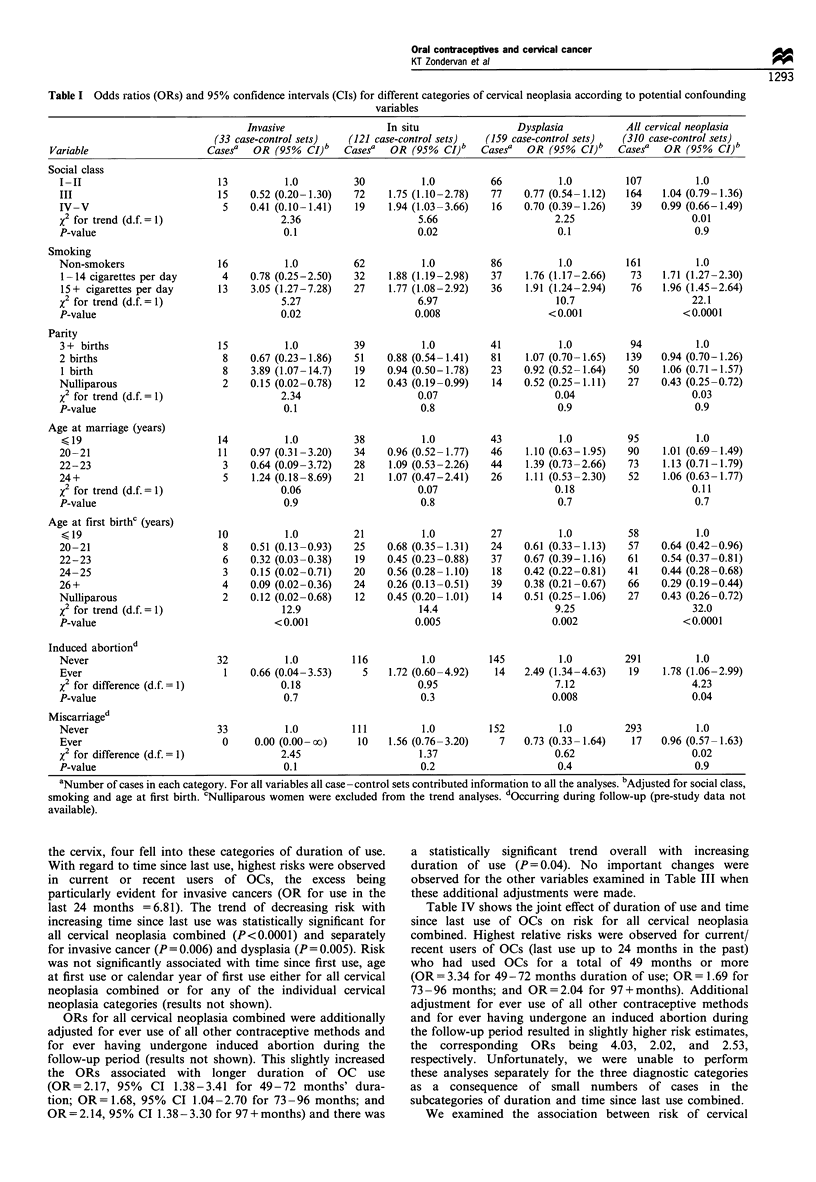
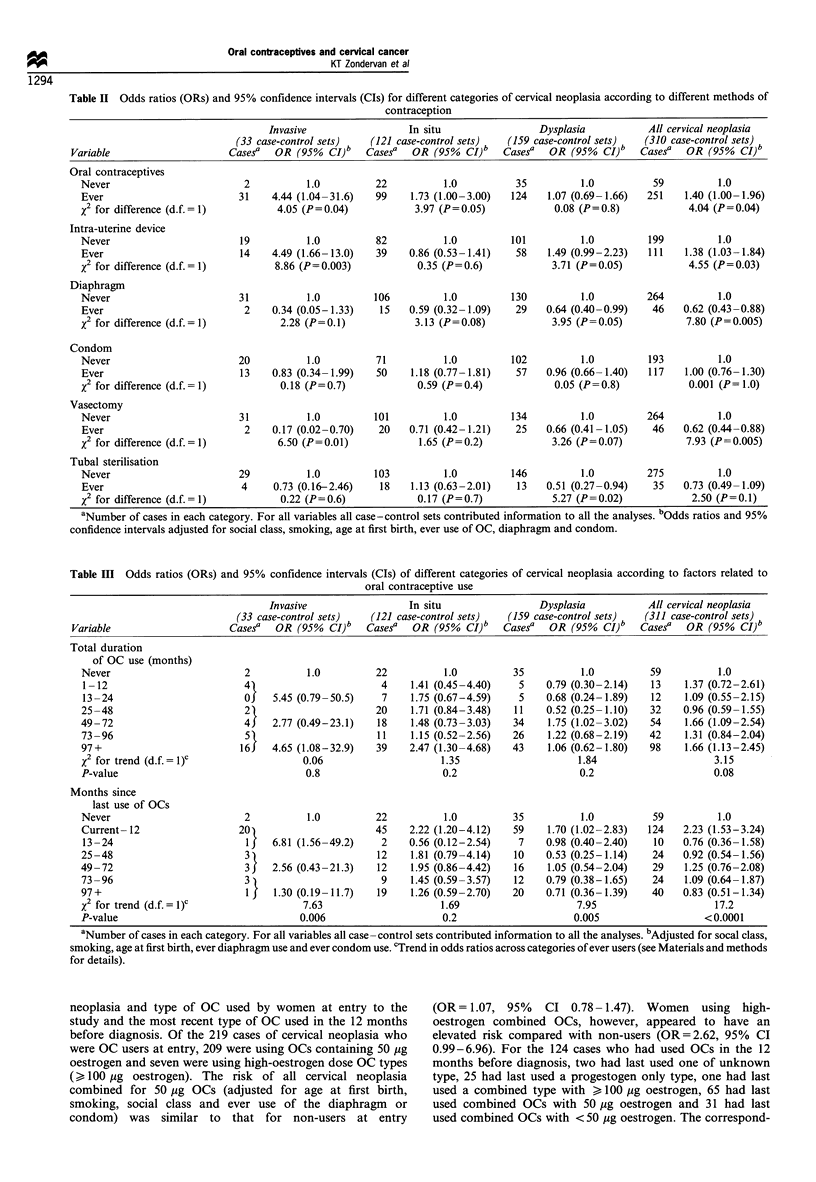
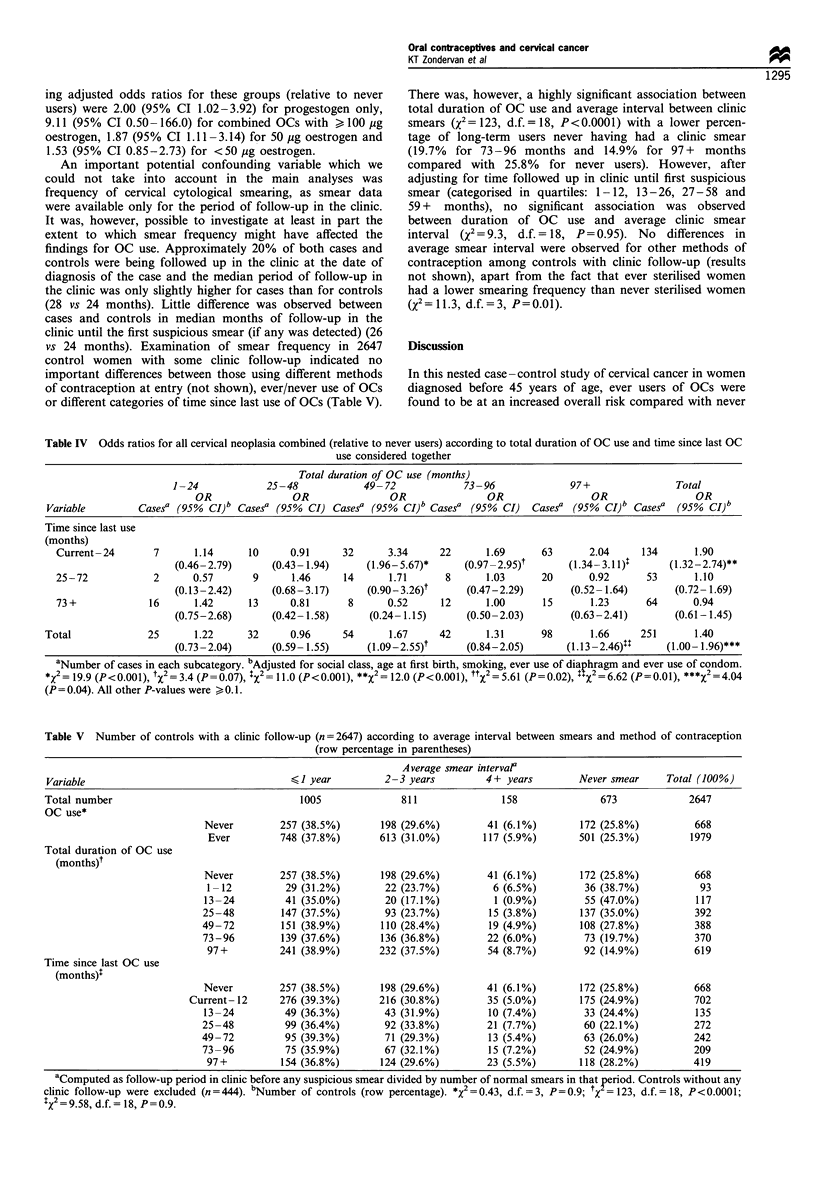
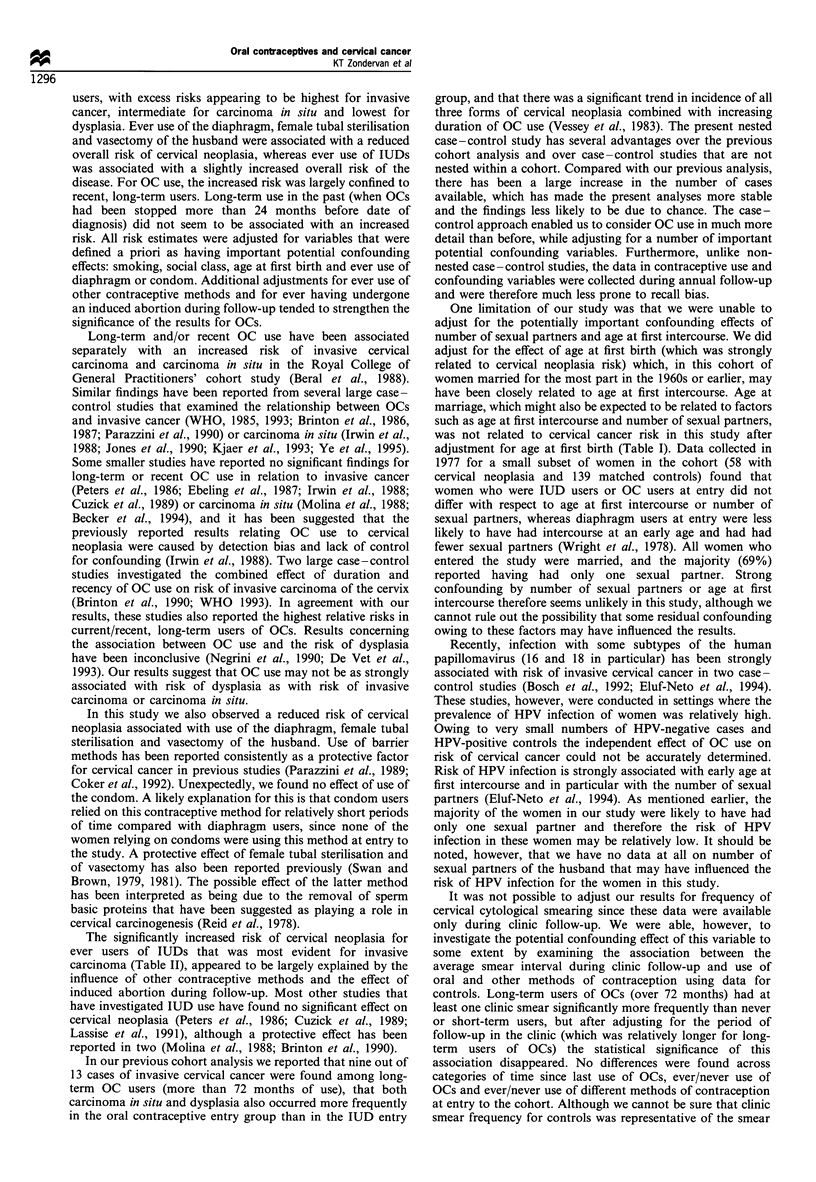
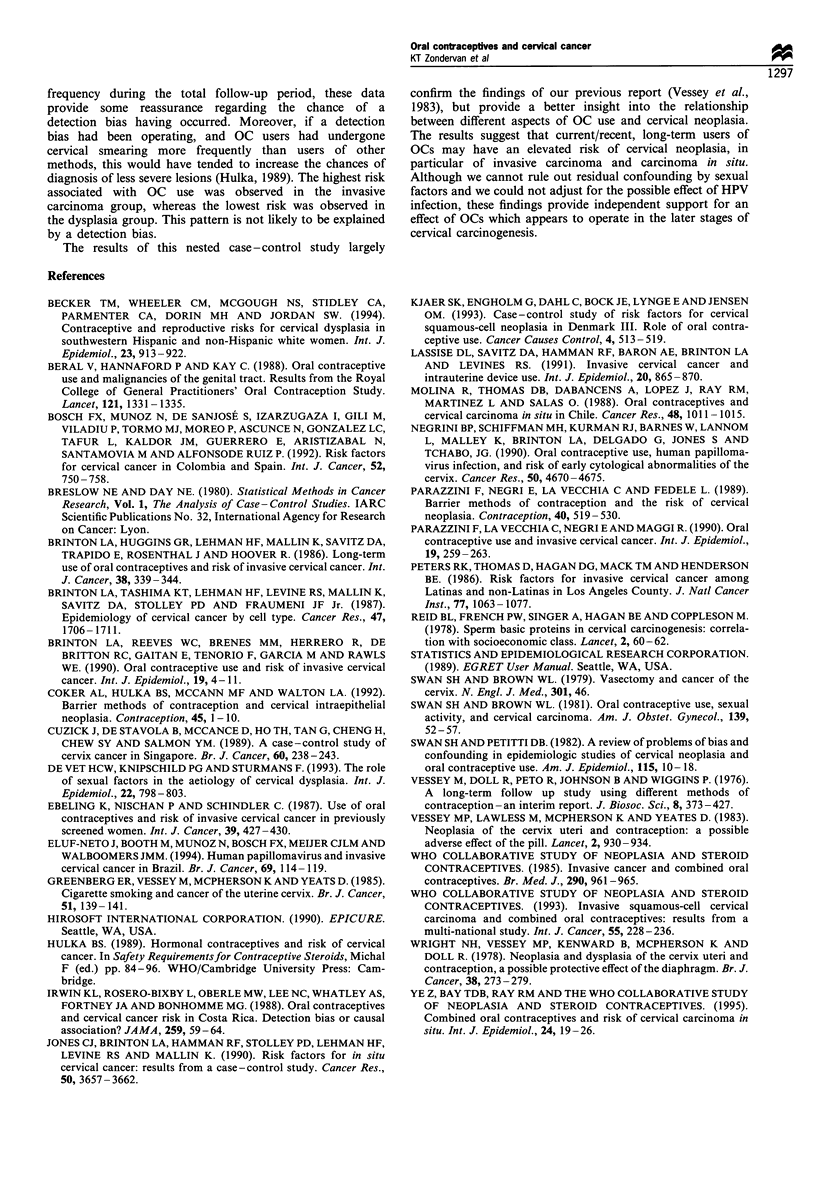
Selected References
These references are in PubMed. This may not be the complete list of references from this article.
- Becker T. M., Wheeler C. M., McGough N. S., Stidley C. A., Parmenter C. A., Dorin M. H., Jordan S. W. Contraceptive and reproductive risks for cervical dysplasia in southwestern Hispanic and non-Hispanic white women. Int J Epidemiol. 1994 Oct;23(5):913–922. doi: 10.1093/ije/23.5.913. [DOI] [PubMed] [Google Scholar]
- Beral V., Hannaford P., Kay C. Oral contraceptive use and malignancies of the genital tract. Results from the Royal College of General Practitioners' Oral Contraception Study. Lancet. 1988 Dec 10;2(8624):1331–1335. doi: 10.1016/s0140-6736(88)90869-0. [DOI] [PubMed] [Google Scholar]
- Bosch F. X., Muñoz N., de Sanjosé S., Izarzugaza I., Gili M., Viladiu P., Tormo M. J., Moreo P., Ascunce N., Gonzalez L. C. Risk factors for cervical cancer in Colombia and Spain. Int J Cancer. 1992 Nov 11;52(5):750–758. doi: 10.1002/ijc.2910520514. [DOI] [PubMed] [Google Scholar]
- Brinton L. A., Huggins G. R., Lehman H. F., Mallin K., Savitz D. A., Trapido E., Rosenthal J., Hoover R. Long-term use of oral contraceptives and risk of invasive cervical cancer. Int J Cancer. 1986 Sep 15;38(3):339–344. doi: 10.1002/ijc.2910380307. [DOI] [PubMed] [Google Scholar]
- Brinton L. A., Reeves W. C., Brenes M. M., Herrero R., de Britton R. C., Gaitan E., Tenorio F., Garcia M., Rawls W. E. Oral contraceptive use and risk of invasive cervical cancer. Int J Epidemiol. 1990 Mar;19(1):4–11. doi: 10.1093/ije/19.1.4. [DOI] [PubMed] [Google Scholar]
- Brinton L. A., Tashima K. T., Lehman H. F., Levine R. S., Mallin K., Savitz D. A., Stolley P. D., Fraumeni J. F., Jr Epidemiology of cervical cancer by cell type. Cancer Res. 1987 Mar 15;47(6):1706–1711. [PubMed] [Google Scholar]
- Coker A. L., Hulka B. S., McCann M. F., Walton L. A. Barrier methods of contraception and cervical intraepithelial neoplasia. Contraception. 1992 Jan;45(1):1–10. doi: 10.1016/0010-7824(92)90136-h. [DOI] [PubMed] [Google Scholar]
- Cuzick J., De Stavola B., McCance D., Ho T. H., Tan G., Cheng H., Chew S. Y., Salmon Y. M. A case-control study of cervix cancer in Singapore. Br J Cancer. 1989 Aug;60(2):238–243. doi: 10.1038/bjc.1989.261. [DOI] [PMC free article] [PubMed] [Google Scholar]
- Ebeling K., Nischan P., Schindler C. Use of oral contraceptives and risk of invasive cervical cancer in previously screened women. Int J Cancer. 1987 Apr 15;39(4):427–430. doi: 10.1002/ijc.2910390402. [DOI] [PubMed] [Google Scholar]
- Eluf-Neto J., Booth M., Muñoz N., Bosch F. X., Meijer C. J., Walboomers J. M. Human papillomavirus and invasive cervical cancer in Brazil. Br J Cancer. 1994 Jan;69(1):114–119. doi: 10.1038/bjc.1994.18. [DOI] [PMC free article] [PubMed] [Google Scholar]
- Greenberg E. R., Vessey M., McPherson K., Yeates D. Cigarette smoking and cancer of the uterine cervix. Br J Cancer. 1985 Jan;51(1):139–141. doi: 10.1038/bjc.1985.21. [DOI] [PMC free article] [PubMed] [Google Scholar]
- Irwin K. L., Rosero-Bixby L., Oberle M. W., Lee N. C., Whatley A. S., Fortney J. A., Bonhomme M. G. Oral contraceptives and cervical cancer risk in Costa Rica. Detection bias or causal association? JAMA. 1988 Jan 1;259(1):59–64. [PubMed] [Google Scholar]
- Jones C. J., Brinton L. A., Hamman R. F., Stolley P. D., Lehman H. F., Levine R. S., Mallin K. Risk factors for in situ cervical cancer: results from a case-control study. Cancer Res. 1990 Jun 15;50(12):3657–3662. [PubMed] [Google Scholar]
- Kjaer S. K., Engholm G., Dahl C., Bock J. E., Lynge E., Jensen O. M. Case-control study of risk factors for cervical squamous-cell neoplasia in Denmark. III. Role of oral contraceptive use. Cancer Causes Control. 1993 Nov;4(6):513–519. doi: 10.1007/BF00052426. [DOI] [PubMed] [Google Scholar]
- Lassise D. L., Savitz D. A., Hamman R. F., Barón A. E., Brinton L. A., Levines R. S. Invasive cervical cancer and intrauterine device use. Int J Epidemiol. 1991 Dec;20(4):865–870. doi: 10.1093/ije/20.4.865. [DOI] [PubMed] [Google Scholar]
- Molina R., Thomas D. B., Dabancens A., Lopez J., Ray R. M., Martinez L., Salas O. Oral contraceptives and cervical carcinoma in situ in Chile. Cancer Res. 1988 Feb 15;48(4):1011–1015. [PubMed] [Google Scholar]
- Negrini B. P., Schiffman M. H., Kurman R. J., Barnes W., Lannom L., Malley K., Brinton L. A., Delgado G., Jones S., Tchabo J. G. Oral contraceptive use, human papillomavirus infection, and risk of early cytological abnormalities of the cervix. Cancer Res. 1990 Aug 1;50(15):4670–4675. [PubMed] [Google Scholar]
- Parazzini F., Negri E., La Vecchia C., Fedele L. Barrier methods of contraception and the risk of cervical neoplasia. Contraception. 1989 Nov;40(5):519–530. doi: 10.1016/0010-7824(89)90125-x. [DOI] [PubMed] [Google Scholar]
- Parazzini F., la Vecchia C., Negri E., Maggi R. Oral contraceptive use and invasive cervical cancer. Int J Epidemiol. 1990 Jun;19(2):259–263. doi: 10.1093/ije/19.2.259. [DOI] [PubMed] [Google Scholar]
- Peters R. K., Thomas D., Hagan D. G., Mack T. M., Henderson B. E. Risk factors for invasive cervical cancer among Latinas and non-Latinas in Los Angeles County. J Natl Cancer Inst. 1986 Nov;77(5):1063–1077. [PubMed] [Google Scholar]
- Reid B. L., French P. W., Singer A., Hagan B. E., Coppleson M. Sperm basic proteins in cervical carcinogenesis: Correlation with socioeconomic class. Lancet. 1978 Jul 8;2(8080):60–62. doi: 10.1016/s0140-6736(78)91378-8. [DOI] [PubMed] [Google Scholar]
- Swan S. H., Brown W. L. Oral contraceptive use, sexual activity, and cervical carcinoma. Am J Obstet Gynecol. 1981 Jan;139(1):52–57. doi: 10.1016/0002-9378(81)90411-7. [DOI] [PubMed] [Google Scholar]
- Swan S. H., Petitti D. B. A review of problems of bias and confounding in epidemiologic studies of cervical neoplasia and oral contraceptive use. Am J Epidemiol. 1982 Jan;115(1):10–18. doi: 10.1093/oxfordjournals.aje.a113264. [DOI] [PubMed] [Google Scholar]
- Vessey M. P., Lawless M., McPherson K., Yeates D. Neoplasia of the cervix uteri and contraception: a possible adverse effect of the pill. Lancet. 1983 Oct 22;2(8356):930–934. doi: 10.1016/s0140-6736(83)90451-8. [DOI] [PubMed] [Google Scholar]
- Vessey M., Doll R., Peto R., Johnson B., Wiggins P. A long-term follow-up study of women using different methods of contraception--an interim report. J Biosoc Sci. 1976 Oct;8(4):373–427. doi: 10.1017/s0021932000010890. [DOI] [PubMed] [Google Scholar]
- Wright N. H., Vessey M. P., Kenward B., McPherson K., Doll R. Neoplasia and dysplasia of the cervix uteri and contraception: a possible protective effect of the diaphragm. Br J Cancer. 1978 Aug;38(2):273–279. doi: 10.1038/bjc.1978.198. [DOI] [PMC free article] [PubMed] [Google Scholar]
- Ye Z., Thomas D. B., Ray R. M. Combined oral contraceptives and risk of cervical carcinoma in situ. WHO Collaborative Study of Neoplasia and Steroid Contraceptives. Int J Epidemiol. 1995 Feb;24(1):19–26. doi: 10.1093/ije/24.1.19. [DOI] [PubMed] [Google Scholar]
- de Vet H. C., Knipschild P. G., Sturmans F. The role of sexual factors in the aetiology of cervical dysplasia. Int J Epidemiol. 1993 Oct;22(5):798–803. doi: 10.1093/ije/22.5.798. [DOI] [PubMed] [Google Scholar]


